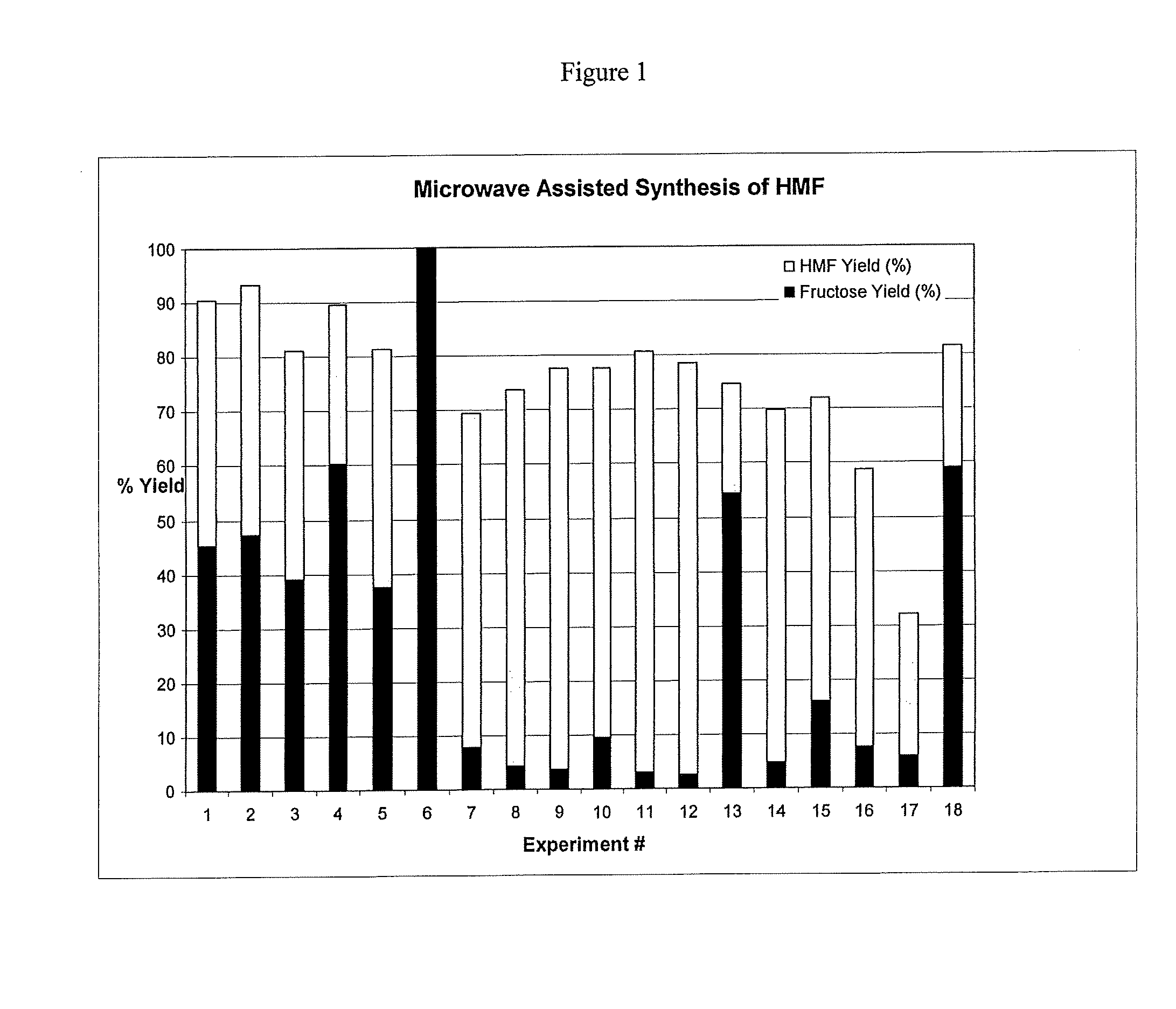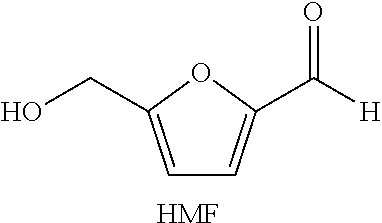Microwave assisted synthesis of dehydrated sugar derivatives hydroxymethylfurfural, levulinic acid, anhydrosugar alcohols, and ethers thereof
a technology of hydroxymethylfurfural and sugar derivatives, which is applied in the field of microwave assisted synthesis of dehydrated sugar derivatives hydroxymethylfurfural, levulinic acid, anhydrosugar alcohols, and ethers thereof, and can solve the problems of increased polymerization reactions and humin formation, low yield of hmf, and rehydration of hm
- Summary
- Abstract
- Description
- Claims
- Application Information
AI Technical Summary
Benefits of technology
Problems solved by technology
Method used
Image
Examples
example 1
[0062]Preparation of HMF in Dimethylacetamide
[0063]A mixture of crystalline fructose (10 g) in dimethylacetamide (30 mL) and Amberlyst 35 wet resin (Rohm and Haas, Woodridge, Ill.) was placed in a sealed Teflon-lined- reaction vessel inside a high-density rotor for treatment in a MicroSYNTH Microwave Labstation. The sample was heated via microwaves from room temperature to 65° C. in 1.5 min., then to 130° C. in 1 min., and kept at 130° C. for 15 min. using an irradiation power of 1000 Watts. The vessel was cooled. Analysis indicates a 42% molar yield of HMF from fructose and 69% conversion (See Experiment 5 in Table 1).
example 2
[0064]Preparation of HMF in Dimethylformamide
[0065]A mixture of crystalline fructose (10 g) in dimethylformamide (30 mL) and Amberlyst 35 wet resin (5 g, Rohm and Haas, Woodridge, Ill.) was placed in a sealed Teflon-lined reaction vessel inside a high-density rotor for treatment in a MicroSYNTH Microwave Labstation. The sample was heated via microwaves from room temperature to 65° C. in 1.5 min., then to 130° C. in 1 min., and kept at 130° C. for 15 min. using an irradiation power of 1000 Watts. The vessel was cooled. Analysis indicates a 41% molar yield of HMF from fructose and 71% conversion (See Experiment 3 in Table 1).
example 3
[0066]Preparation of HMF in NMP
[0067]In a first experiment, a mixture of crystalline fructose (10 g) in NMP (25 mL) and concentrated H2SO4 (0.1 mL) was placed in a sealed Teflon-lined reaction vessel inside a high-density rotor for treatment in a MicroSYNTH Microwave Labstation. The sample was heated via microwaves from room temperature to 140° C. in 3 min., and kept there for 20 min. using an irradiation power of 1000 Watts. The vessel was cooled. Analysis indicates a 65% molar yield of HMF from fructose.
[0068]In another experiment, a mixture of crystalline fructose (10 g) in NMP (25 mL) and concentrated H2SO4 (0.1 mL) was placed in a sealed Teflon-lined reaction vessel inside a high-density rotor for treatment in a MicroSYNTH Microwave Labstation. The sample was heated from room temperature to 160° C. in 3 min., and kept there for 20 min. using an irradiation power of 1000 Watts. The vessel was cooled. Analysis indicates a 77% molar yield of HMF from fructose. These same condition...
PUM
| Property | Measurement | Unit |
|---|---|---|
| temperature | aaaaa | aaaaa |
| temperature | aaaaa | aaaaa |
| temperature | aaaaa | aaaaa |
Abstract
Description
Claims
Application Information
 Login to View More
Login to View More - R&D
- Intellectual Property
- Life Sciences
- Materials
- Tech Scout
- Unparalleled Data Quality
- Higher Quality Content
- 60% Fewer Hallucinations
Browse by: Latest US Patents, China's latest patents, Technical Efficacy Thesaurus, Application Domain, Technology Topic, Popular Technical Reports.
© 2025 PatSnap. All rights reserved.Legal|Privacy policy|Modern Slavery Act Transparency Statement|Sitemap|About US| Contact US: help@patsnap.com



